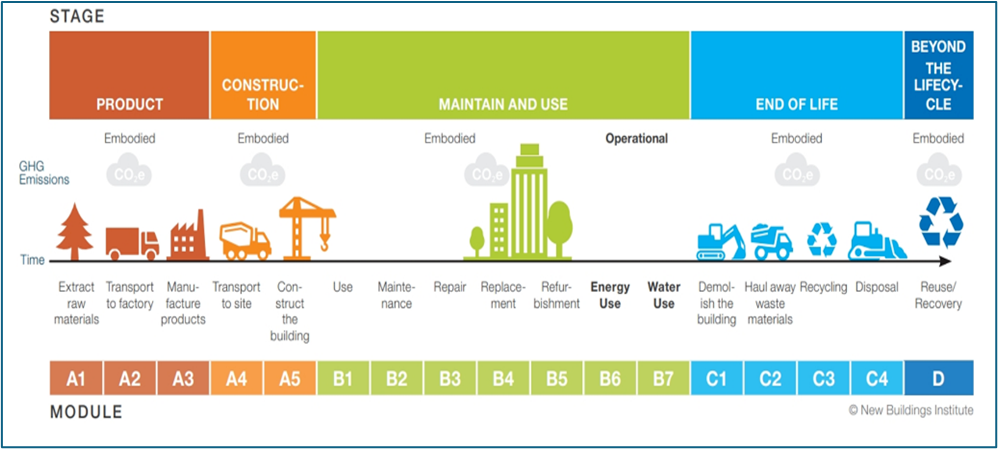Member Knowledge Centre
 member Knowledge centre
member Knowledge centre
The Knowledge Centre provides CHBA members with access to information and resources. It is a growing resource that is currently focused on updating members about national building code information. Please note that this information is a benefit of your membership, and should not be shared beyond your company/organization.
You can browse the items below, filter by category, or enter search terms in the "What are you looking for" box below.
Reducing Embodied Carbon Emissions

Reducing Embodied Carbon Emissions

Reducing Embodied Carbon Emissions
Reducing Embodied Carbon Emissions
In Canada, the process of newly constructing an average (2,000 sqft) home is estimated to generate about 28 tonnes of greenhouse gas emissions – or 186 kg of CO₂ equivalent per square metre. These values are often referred to as the cradle-to-gate emissions or embodied Greenhouse Gas emissions of the home.
Long before the home exists, these emissions are released by machinery and operating buildings and vehicles during the production stage of building materials, including emissions released from the soil during raw material extraction, and from transporting the material to and from manufacturing facilities, processing, and fabrication. Over the life of the building, additional emissions can occur during the construction stage, maintenance and renovation activities, and eventual deconstruction, demolition or decommissioning. They are called 'embodied' emissions because they occur up-front and remain permanently associated with (or embedded in) the building materials, regardless of how efficiently a building constructed with these materials is operated over its lifetime.

According to an estimate in a 2025 Builders for Climate Action and Natural Resources Canada report the total embodied GHG emissions for all new low-rise residential buildings constructed annually amounts to 20 million tonnes of CO₂e. The same report found that cradle-to-gate embodied emissions for homes of similar design and energy performance can vary widely, ranging from 86 kg CO₂e/m² to as high as 561 kg CO₂e/m², depending largely on the choice of construction materials and their respective embodied GHG emissions. Considering that governments expect housing starts to double and that simple material choices can reduce the carbon footprint of residential construction, it may be worthwhile for the industry to consider simple and practical steps toward reducing GHG emissions.
Technical Concepts
Whole Life Carbon Assessment (LCA) is a method of evaluating the whole-life carbon emissions of a system, component, product, assembly, or building, from the extraction of raw materials, followed by transportation, processing, manufacturing, use, maintenance, and end-of-life treatment including recyclability, and disposal. Some stages of the life cycle are more GHG intensive than others.
Environmental Product Declaration (EPD) is a standardized document that reports a product’s environmental impact based on an LCA. It’s based on verified data and enables comparison between products within the same product category group. This supports informed decision-making and the selection of lower-carbon options.
Cradle-to-Gate refers to the environmental impacts that occur from the extraction of raw materials (“cradle”) through manufacturing and processing, up to the point where the product leaves the factory (“gate”). This corresponds to modules A1 to A3 in the LCA framework, collectively known as the product stage. For building materials, this stage is typically estimated to account for 60–75% of the total embodied carbon emissions over the full life cycle.
Cradle-to-Practical Completion (Home Occupancy) refers to the environmental impacts that occur from raw material extraction through manufacturing, transport to site, and installation. Transportation to site and on-site construction activities are estimated to each add roughly 5–10% to the total embodied CO2e emission.
Cradle-to-Grave refers to the full life cycle of a product, including all environmental impacts from raw material extraction through manufacturing, transport, installation, use, maintenance, and end-of-life treatment including disposal or recycling.
Cradle-to-Cradle describes a regenerative design philosophy where products are created with the intention of continuous reuse. At the end of their useful life, materials are either recovered and recycled into new products, re-used, or repurposed. Or they are safely returned to the environment, eliminating the concept of waste.
Modelling Tools are web-based or spreadsheet-based calculators that designers can use to estimate the material-related GHG emissions of a building. Some common tools used in residential construction are MCE² (by Natural Resources Canada), BEAM (by Builders for Climate Action), and the Impact Estimator for Buildings (by Athena Sustainable Materials Institute). The calculations are based on EPDs for each product.
What does the National Building Code say?
The 2025 National Building Code does not require compliance with material carbon emissions. It is expected that material emissions will be regulated in the 2030 edition of the National Building Code. The draft policy directive envisions a tiered framework that supports both performance-based and prescriptive compliance approaches, which would only applies to structural materials and consider only lifecycle stages A1 through A3.
How to Reduce Embodied Emissions
Reducing embodied GHG emissions requires a combination of careful planning, informed material choices and design decisions. Builders should be most focused on the initial stages of the carbon life cycle, such as the building materials and construction practices. Through the use of modelling tools builders and renovators can estimate cradle-to-gate emissions and learn which materials contribute most to the carbon footprint of a home.
The following approaches show promise in being effective in reducing embodied GHG emissions:
• Reducing overall building size – directly lowers material demand and associated emissions. However, it is important to note that the reduction in emissions relative to building footprint is not linear; beyond a certain point, further decreases in footprint result in diminishing emission savings (entire life cycle).
• Renovating, rather than demolishing and building new – reduces emissions by using a mix of existing and new material. Contributes to circular economy of material (entire life cycle).
• (Re-)Using salvaged, refurbished, or low-carbon materials – can significantly reduce the embodied carbon of a project (A1 to A3).
• Choosing low-carbon options among equivalent materials – within the material class of ‘concrete’ there are some lower-carbon types that may be suitable for some projects. Another example would be insulation, such as using blown-in fibreglass instead of batt (A3).
• Replace high-carbon materials with low-carbon choices – Replacing concrete or steel with wood (e.g. mass timber) could further decrease GHG contributions. Some EPDs, unless indicated otherwise within the document, can be used by designers and builders to roughly compare the environmental impacts of different building materials within the same product category group and make informed choices (A1 to A3).
• Sourcing materials locally – would reduce transportation emissions (A3)
• Reducing, reusing and recycling offcuts – on-site practices like preventing unnecessary waste or making sure waste is recycled will reduce GHG emissions counted for the construction process of a home (A4 to A5)
• Using electric construction equipment – using electric tools can further reduce emissions during the construction phase (A5) wherever the utility electricity is generated with cleaner energy than gas.
By combining these strategies, projects can substantially lower their overall carbon footprint while supporting more sustainable construction practices. Many of these practices and design strategies are cost-effective or even cost-neutral.
Early Stages
Reducing embodied carbon is an important part of building more sustainably. There are however still challenges for designers, especially when considering that embodied GHGs will soon be regulated:
• Today’s homes are the lowest carbon housing form – Wood-framed houses, for instance, already have relatively low embodied carbon, which means the room for further reductions is limited to the concrete foundation and the envelope system.
• Fair Comparison – Even though EPDs comply with international standards, they are not intended to serve as comparative labels between different product categories. This makes it difficult to fairly compare materials that fulfill different functions or are governed by different Product Category Rules (PCRs).
• Uncertainty – NRCan’s Material Carbon Emissions calculator relies on EPDs which typically carry a range of uncertainty from 5% to 25%, making them a low-precision reference that may not be suitable for calculating emission targets until the precision of this data is increased.
• Lack of standardization – To make real progress, the industry needs more accurate standards – consistent throughout an entire product category – that allow the comparison of products across different categories, so that reductions can be pursued where they are most effective and meaningful.
CHBA will continue to encourage governments to regulate the building material supply chain (product manufacturers) to achieve reductions in embodied emissions rather than builders and renovators. The cost and administrative burden of reporting and reducing embodied GHG emissions for their end-use in homes seems to exceed the benefits that can be achieved for today’s relatively small, wood-frame constructed homes. CHBA envisions embodied carbon standards being integrated into materials standards where materials and products must meet recognized performance standards.
Resources
More information can be found in the following reports and guides, Pathways to Embodied Carbon Regulation in Canada’s Building Codes, MCE2 user guide , and the National Whole Building Practitioners Guide.
Additional Info
Download File : Understanding Embodied Emissions Backgrounder.pdf
